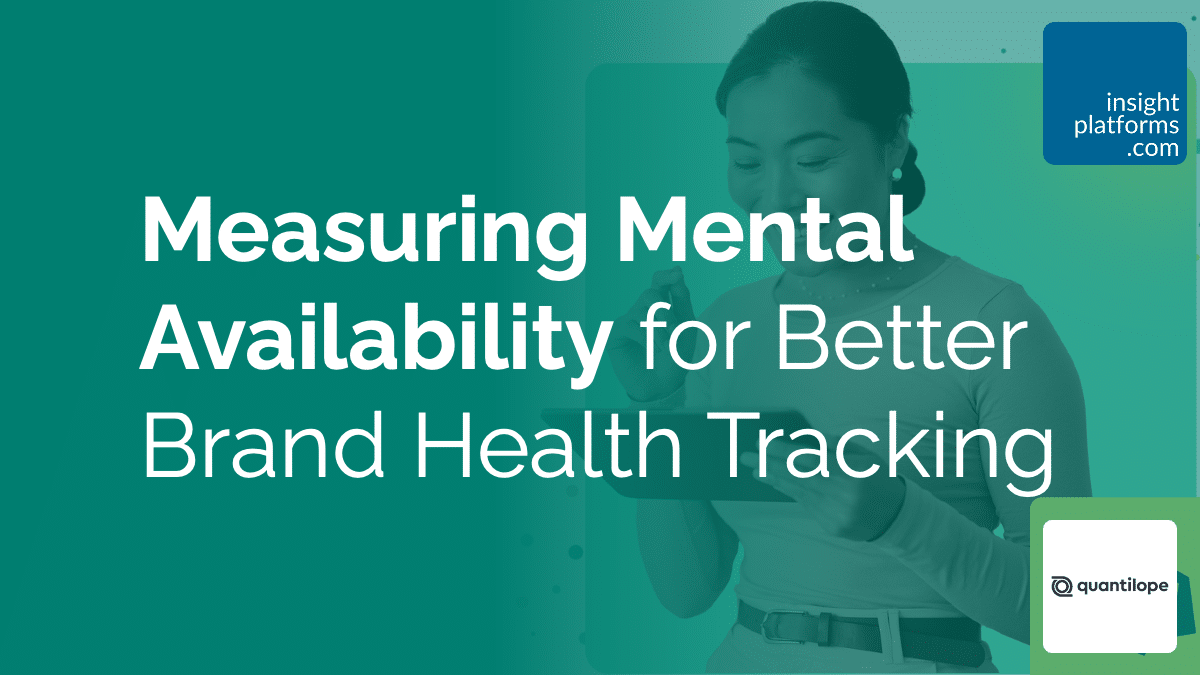
Measuring Mental Availability for Better Brand Health Tracking
By quantilope
- article
- Brand Tracking
- Brand Research
- Real-Time Consumer Feedback
This article is a brief summary of quantilope Research’s Demo Days session in February 2025.
quantilope Demo: Unlock Growth: Better Brand Health Tracking with Mental Availability & Mental Advantage
The field of brand tracking research is undergoing significant change, particularly in how brand health is measured and understood. One key development is the rise of automated platforms that integrate contemporary brand growth theories into their measurement frameworks. quantilope’s Better Brand Health Tracking (BBHT) approach offers an example of how traditional brand tracking metrics can be augmented with newer conceptual frameworks.
Stay up to date
Subscribe to receive the Research Tools Radar and essential email updates from Insight Platforms.
Your email subscriptions are subject to the Insight Platforms Site Terms and Privacy Policy.
The approach incorporates concepts from Byron Sharp’s “How Brands Grow” and Jenni Romaniuk’s “Better Brand Health”. These books suggest that brand growth is a function of physical and mental availability. Although Physical Availability is typically out of the control of marketers and consumer insights teams, marketing and advertising efforts can very directly impact Mental Availability and, therefore, overall brand growth. By moving beyond traditional awareness metrics and assessing how easily brands come to mind in actual purchasing situations, brands can connect marketing efforts to sales data.
About the Better Brand Health Tracking (BBHT) Approach
BBHT’s core metrics reflect this theoretical foundation. Mental Market Share gauges a brand’s presence in consumers’ minds and has been validated against actual sales data. Mental Penetration provides a more comprehensive alternative to traditional awareness metrics by measuring the percentage of consumers with at least one linkage between a brand and a buying situation. Network Size quantifies the average number of associations consumers hold with a brand.
A distinct feature of the approach is its use of Category Entry Points (CEPs) — the moments, needs, or situations that lead someone to become a potential category purchaser. These are developed through a structured process using the “7Ws” framework, combining workshops, AI assistance, and implicit association testing to identify each category’s most relevant entry points.
Mental Advantage Analysis is another innovative metric that compares expected versus actual brand performance on CEPs. This helps identify areas where brands are over or under-performing relative to their size and market position, highlighting vulnerabilities or growth opportunities.
quantilope’s Consumer Intelligence Platform integrates automated data collection with real-time analysis. Interactive dashboards provide live statistical significance testing and wave-over-wave analysis, while an AI co-pilot called quinn assists with automated insight generation. The system maintains flexibility in data collection while ensuring consistency in analysis and reporting.
Reporting capabilities cater to stakeholder needs through customisable dashboards and traditional PowerPoint exports. This adaptability supports implementation across various organisational contexts and user requirements.
Implementation and Impact
Discussions with users indicate that marketing teams particularly value BBHT’s ability to connect mental availability metrics to actual market performance. Its capacity to pinpoint specific buying situations informs communication strategies and ad campaigns, making the theoretical framework more actionable.
Implementation support plays a crucial role in the platform’s offering. Research experts provide consulting services, especially during initial setup, to ensure the correct configuration of metrics and category entry points. This acknowledges the need for technical proficiency and methodological expertise in successful adoption.
quantilope’s platform and approach to Better Brand Health Tracking exemplifies an evolving direction in brand tracking, aiming to automate and standardise newer theoretical frameworks while maintaining methodological integrity. Its approach to Mental Availability measurement and Category Entry Points delivers a structured and practical way to implement contemporary brand growth theories.
Traditional metrics like awareness remain relevant, however, approaches like this suggest how brand tracking could evolve to provide more actionable insights for modern marketing teams. Leveraging automation enhances efficiency and consistency in measurement, which ensures that brand tracking keeps pace with the complexities of modern consumer behaviour.
Watch the webinar to learn more about the quantilope platform.



